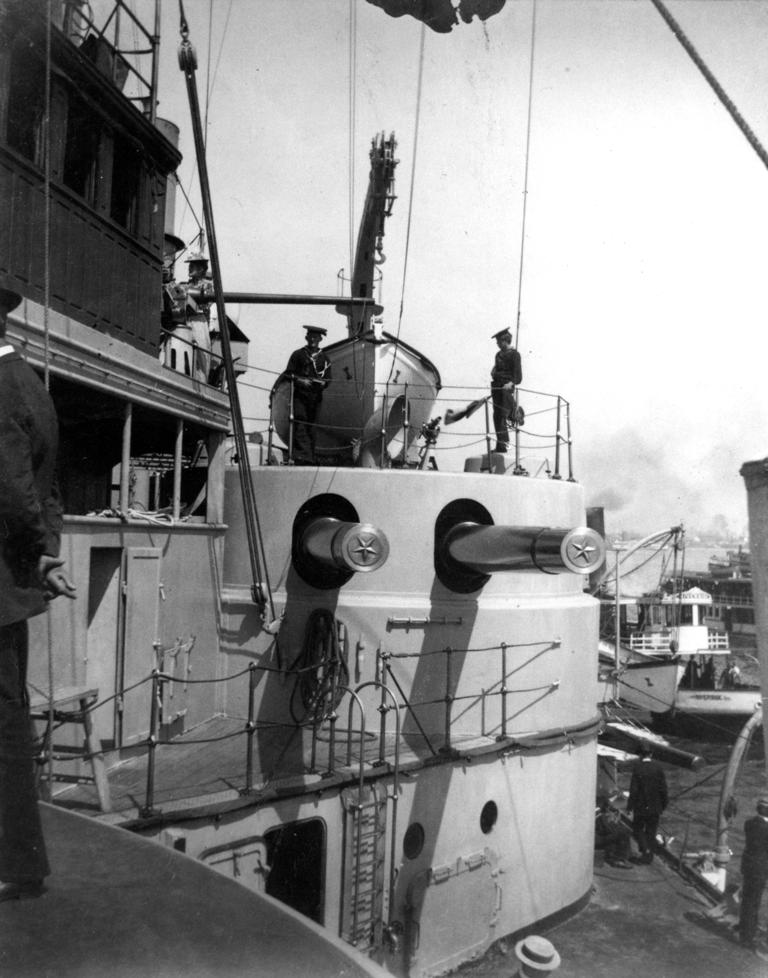
The late 1800s saw the development of slower-burning brown or "cocoa" powder. This propellant allowed longer, higher muzzle velocity weapons to be developed, but wasted much of its energy producing clouds of thick smoke. Experience gained with the earlier 8"/30 (20.3 cm) guns led to a simpler construction for these longer guns.
During the Battle of Manila Bay in 1898, USS Olympia fired an 8" (20.3 cm) shell from one of her 8"/35 (20.3 cm) guns that struck the Spanish flagship Reina Christina "squarely in the stern and drove through the length of the ship, rending every obstruction, wrecking the aft boiler, and blowing open the deck in its explosion. This one shell proved the flagship's fate" - Ivan Musicant in "U.S. Armored Cruisers."
The 8"/35 (20.3 cm) Mark 3 gun barrels intended for Brooklyn (ACR-3) and Iowa (B-4) were initially rejected by the Bureau of Ordnance, as they were honeycombed with small "sand splits," a result of the excessive amounts of clay and slag used in the gun metal. However, after a delay of two years, they were accepted at a reduced cost. Three of these guns on Iowa subsequently blew off their muzzles during a gunnery exercise in 1904. See photograph below.
The Mark 3 Experimental was a 30 caliber gun that used trunnions and had 11 hoops with the outer hoop starting 4 inches (10.2 cm) from the breech and running out to the muzzle. The production Mark 3 Mod 0 was a trunnioned 35 caliber gun that had 11 hoops with the outer hoop starting 4 inches (10.2 cm) from the breech and running out to 43.5 inches (110.5 cm) from the muzzle. This gun was removed from service prior to World War I. The Mark 3 Mod 1 was constructed of tube, jacket and eight hoops while Mod 2 was identical to Mod 1 but with different steps under the chase hoops. Mod 3 was for one gun lengthened to 40 calibers and was removed from service prior to the start of World War I. Mod 4 was for one gun with minor changes from Mod 3. Mod 5 had the trunnions removed and the outer jacket threaded to accept a sleeve.
The original Mark 4 guns were identical to Mark 3 Mod 1 guns with the trunnion hoop and elevating band removed and with the threads formerly under the trunnion hoop being continued to the rear of the gun. This allowed these guns to be screwed into the sleeve of a two-gun turret mount. Mark 4 Mod 1 was one Mark 4 gun shortened by 0.66 inches (1.7 cm) in rear of the threads. Mods 2 through 9 were for minor differences primarily for testing different mounting techniques. Mod 10 was for one gun cut down to 23 calibers and used for experimental work with high-explosive shells.
Mark 5 was a new 40 caliber design intended for armored cruisers and battleship secondaries and constructed of tube, jacket, three hoops and one locking ring. The barrel had a muzzle bell. Unfortunately, the Mark 5 proved to be unable to handle the transition from black powder to nitrocellulose propellants as the new propellant burned more slowly, allowing the pressure to build up to unsafe levels as the projectile traveled down the bore. This problem was illustrated when USS Colorado (ACR-7) blew off the muzzle of one of her 8"/40 (20.3 cm) guns during gunnery practice off Chefoo, Shantung, on 22 June 1907. All Mark 5 guns were subsequently removed from service, lengthened to 45 calibers by adding a new liner and re-hooping to the muzzle, redesignated as Mod 1 and then placed into reserve. Two of these Mod 1 guns were given a slightly different breech mechanism and gas seat and then redesignated as Mod 2. The Pennsylvania class (ACR-4) was subsequently rearmed with the stronger 8"/45 (20.3 cm) Mark 6.
| Designation | 8"/35 (20.3 cm) Marks 3 and 4
8"/40 (20.3 cm) Mark 5 |
|---|---|
| Ship Class Used On | 8"/35 (20.3 cm)
Battleships: Indiana (B-1), Iowa (B-4) and Kearsarge (B-5) Cruisers: New York (ACR-2), Brooklyn (ACR-3), Charleston (C-2), Baltimore (C-3) and Olympia (C-6) classes 8"/40 (20.3 cm)
|
| Date Of Design | about 1890 |
| Date In Service | Mark 3: 1889
Mark 5: 1894 |
| Gun Weight | Mark 3: 29,400 lbs. (13,336 kg) without breech block
Others: N/A |
| Gun Length | 8"/35 (20.3 cm) Marks 3 and 4: 261.0 in (6.629 m)
8"/40 (20.3 cm) Mark 5: 343.0 in (8.712 m) |
| Bore Length | Mark 3 and 4: 280 in (7.112 m)
Mark 5: 320 in (8.128 m) |
| Rifling Length | N/A |
| Grooves | N/A |
| Lands | N/A |
| Twist | Mark 3 and Mark 4: Increasing RH 0 to 1 in 25
Mark 5: N/A |
| Chamber Volume | N/A |
| Rate Of Fire 1 | 1890s: 0.5 to 0.8 rounds per minute
1900s: 2 - 2.8 rounds per minute |
- ^In 1897 the 8"/35 (20.3 cm) gun was timed at one shot every 120 seconds (2 minutes). This was greatly improved by more careful loading practices and better training so that by a decade later a rate of 30 seconds or less was achieved. For example, USS New York as commissioned in 1893 was timed at one round every 77 seconds. At the annual fleet exercise in 1905, one of her gun crews fired 2.8 rounds per minute and was able to score seven hits in 2.5 minutes.
- Early guns used percussion firing. Later guns used a Fletcher Breech (down-swinging carrier type) which allowed electrical firing.
| Type | Bag |
|---|---|
| Projectile Types and Weights | AP - 260 lbs. (118 kg)
Common - 260 lbs. (118 kg) |
| Bursting Charge | AP - 5.0 lbs. (2.3 kg) Black Powder
Common - 8.0 lbs. (3.6 kg) Black Powder |
| Projectile Length | N/A |
| Propellant Charge | 43.8 lbs. (19.9 kg) |
| Muzzle Velocity | 8"/35 (20.3 cm): 2,100 fps (640 mps)
8"/40 (20.3 cm): 2,500 fps (762 mps) |
| Working Pressure | N/A |
| Approximate Barrel Life | N/A |
| Ammunition stowage per gun | Indiana: 75 rounds
Kearsarge and Brooklyn: 125 rounds Others: N/A |
| Elevation | Range |
|---|---|
| 20.1 degrees | 16,000 yards (14,630 m) |
| Range | Side Armor | Deck Armor |
|---|---|---|
| 6,000 yards (5,490 m) | 5.6" (142 mm) | --- |
| 9,000 yards (8,230 m) | 4.1" (104 mm) | --- |
| 12,000 yards (10,920 m) | 2.9" (74 mm) | --- |
This data is from "Elements of US Naval Guns" of 1918 as published in "US Naval Weapons". It is corrected for angle of fall and may also refer to harder armor than used for the 1905 data.
| Designation | Single center-pivots
New York (2), Charleston (2), Baltimore (2), and Columbia (1): Mark 3 and Mark 4 Twin Turrets
Dual-Caliber Turret
|
| Weight | N/A |
| Elevation | Marks 3 and 4: -5 / +20 degrees
Marks 5 and 6: -4 / +13 degrees Mark 7: -7 / +14 degrees Mark 8: -7 / +14 degrees Mark 9: -7 / +14 degrees |
| Elevation Rate | N/A |
| Train | Bow and Stern Mountings: - 150 / +150 degrees
New York Amidships Mountings: 140 degrees 4a Brooklyn Amidships Mountings: 180 degrees 5a |
| Train Rate | N/A |
| Gun recoil | N/A |
| Loading angle | Marks 3 and 4: Any angle
Marks 5, 6 and 7: 0 degrees Others: N/A |
- ^1.11.2During modernizations USS New York and the Pennsylvania class were rearmed with 8"/45 (20.3 cm) Mark 6 guns.
- ^USS Olympia (C-6) had her 8" (20.3 cm) guns removed along with their armored barbettes and turrets in 1916.
- ^The four Mark 8 turrets on USS Brooklyn were split into two steam powered and two electrical powered mountings in order to evaluate the advantages of each system. General Electric installed a modified Ward-Leonard system into the two electrically powered mountings. Tests on 3 March 1896 proved that the electric turrets were far superior to the steam-powered turrets in terms of smoothness and reliability and this system was adopted for future construction.
- ^The amidships mountings on USS New York had a theoretical arc of 180 degrees, thus allowing axial fire, but in practice the firing arcs were limited to 140 degrees in order to minimize the blast effect on the deck and superstructure.
- ^USS Brooklyn was the only US ship to be designed with her turrets in a lozenge arrangement. Thanks to the extreme tumble home of the hull, the wing turrets could fire directly forward and aft. She put this to good use at the Battle of Santiago, where her captain, Francis Cook, reported that "our tumbling-in sides enabled us to maintain continual fire while turning."
- None of these turrets were balanced, which means that training them abeam created a list.
- The Mark 4 had a single-casting slide. Mark 5 used gravity return, possible that so did Mark 6. Mark 5 used steam-powered hydraulic pumps for elevation and training, with manual backup gear. Ammunition hoists were electrically driven with both steam and manual backup gear.
- Mark 7 and Mark 8 used the "grass-hopper" counter recoil system whereby a spring box, located under the gun pit, was connected via two heavy, pivoted arms to the gun yoke. See 10"/40 (25.4 cm) datapage for a sketch.
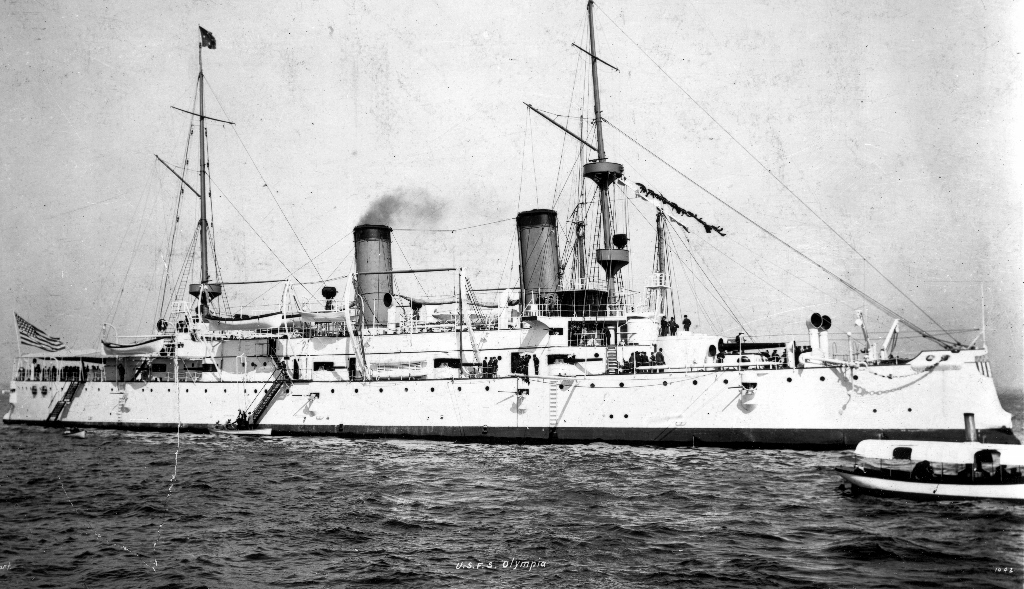
This photograph shows the typical US cruiser of the late 1800s period - 8" (20.3 cm) guns in turrets, 5" (12.7 cm) guns in the superstructure, 1-pdrs along the hull. U.S. Naval Historical Center Photograph # NH 2894.
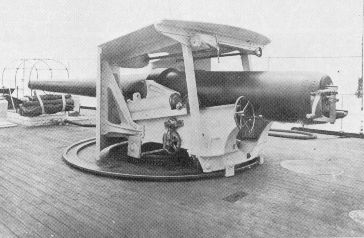

U.S. Naval Historical Center Photograph # NH 85672.
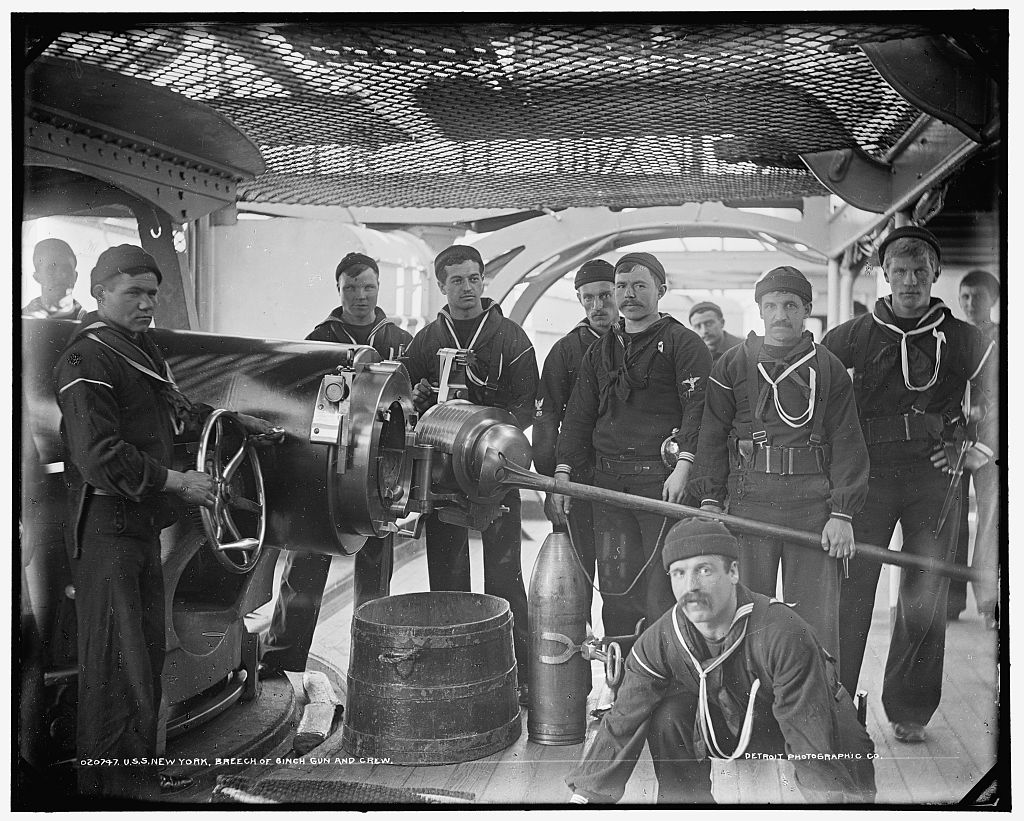
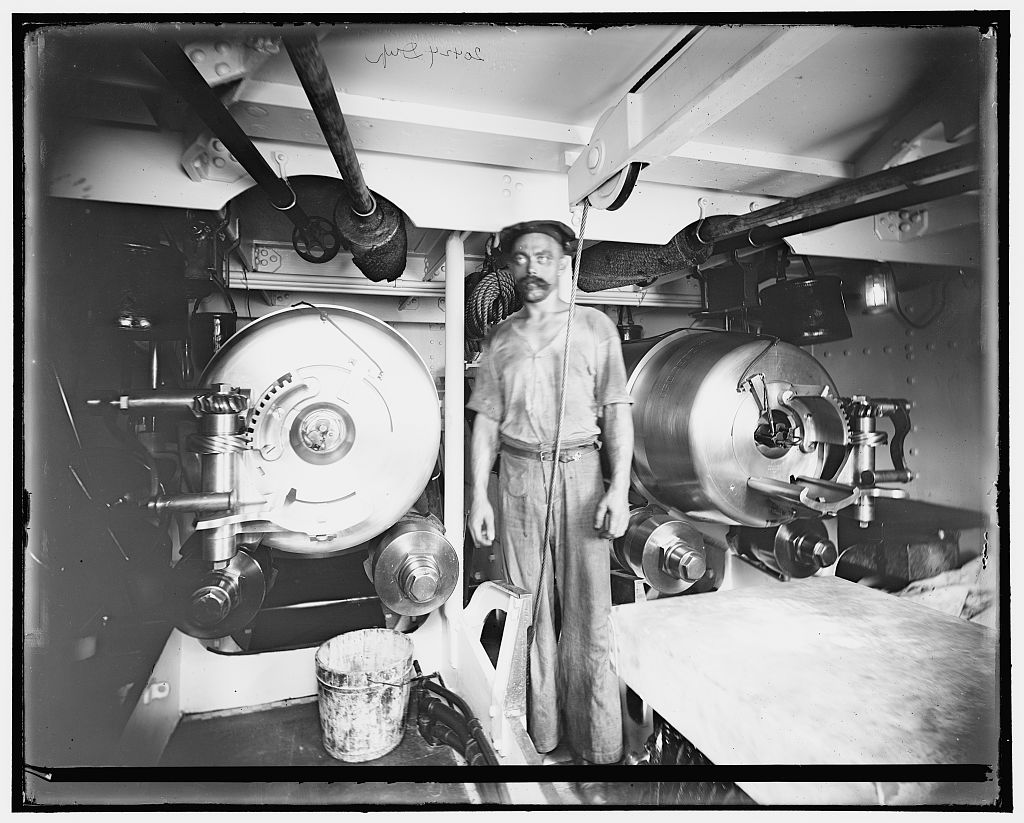
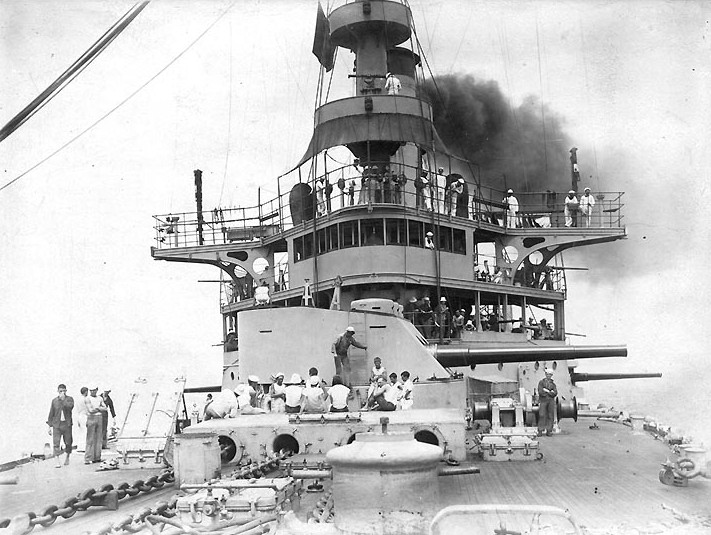
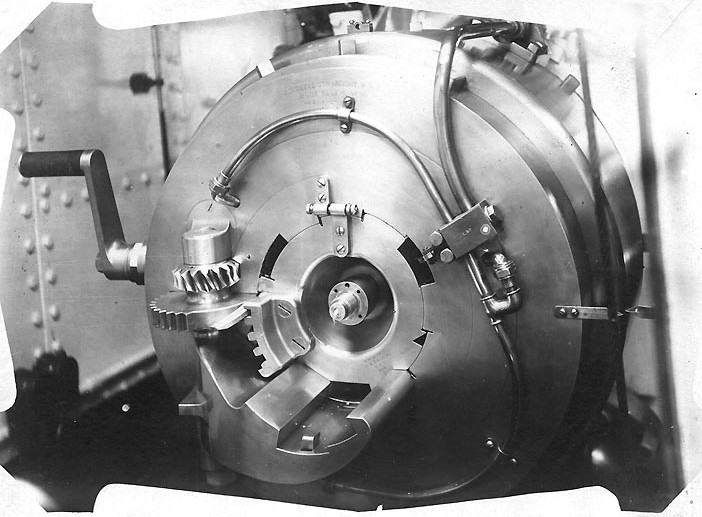
U.S. Naval Gun Factory W.N.Y.
[Washington Navy Yard]
8 in. Gun Mark V No. 98
U.S. Naval Historical Center Photograph # NH 73128.
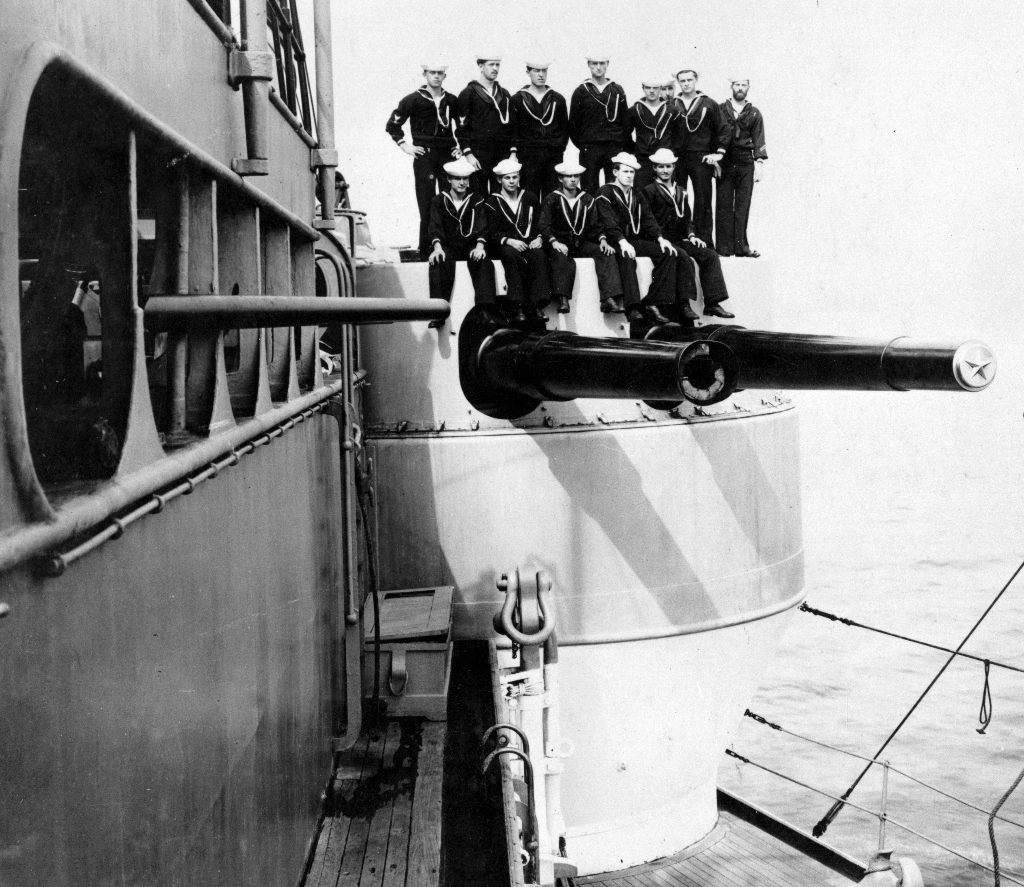
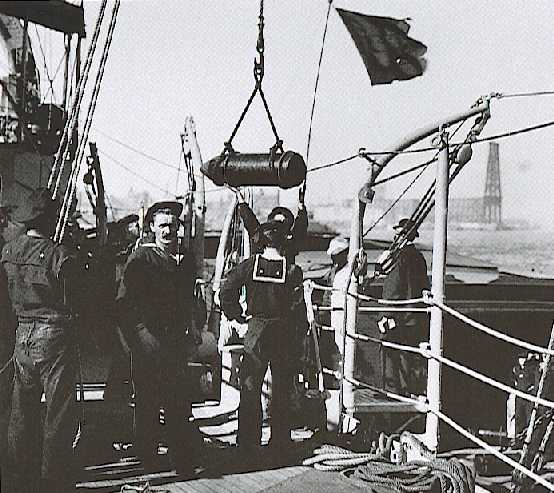
"U.S. Battleships: An Illustrated Design History" and "US Naval Weapons" both by Norman Friedman
"U.S. Armored Cruisers: A Design and Operational History" by Ivan Musicant
"Battleships" by Paul Stillwell
---
"United States Naval Guns: Their Marks and Modifications" Ordnance Pamphlet No. 127, December 1916, Revised January 1918
---
Gene Slover's Navy Pages
18 September 2008 - Benchmark
06 January 2009 - Added two pictures of USS Maryland
04 June 2009 - Added information on Common projectiles, corrected typographical error
07 October 2011 - Added two mislabeled Library of Congress Photographs
11 May 2015 - Added gun details, redid photographs of Indiana and Iowa, and replaced photograph of Olympia
12 March 2016 - Corrected typographical error
29 July 2016 - Converted to HTML 5 format
07 July 2018 - Corrected typographical error
23 October 2020 - Added ammunition data, reorganized notes
10 June 2023 - Removed photograph
18 February 2025 - Added regunning note for USS Olympia (C-6) and reorganized mounting notes
